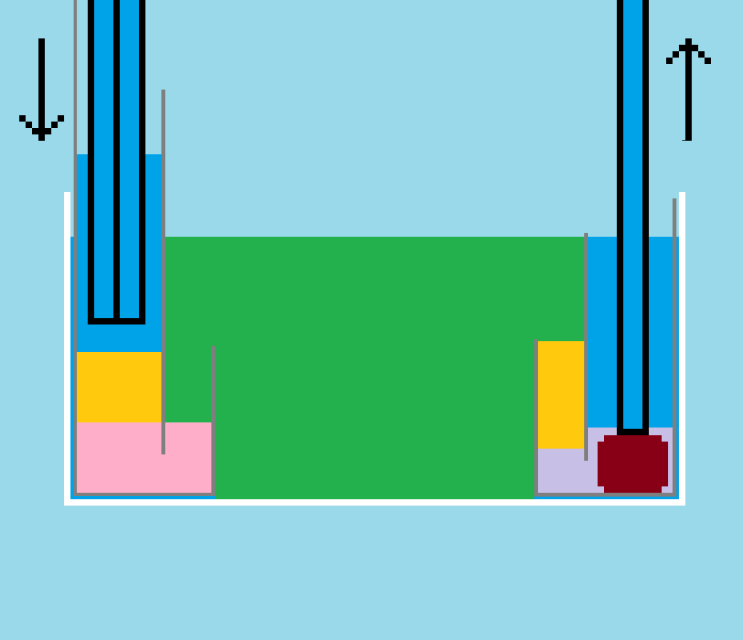Okay, based on this conversation and other exploration, I've made some modifications... Same general concept, but modified details.
Color Code...
light blue is air
darker blue is water
yellow/gold is sponges
pink (bottom left) is biomedia, whatever rings, balls, scrubbies, etc I have laying around
lavender (bottom right) filter floss / quilt batting / water polishing media
I've scrapped the concrete board for the inserts. I'm using corrugated plastic, which is basically plastic cardboard. Check it out on Amazon if curious. I bought 2'x3' sheets. I've worked with it before. Silicone works well on it. The walls of the baffles were thinnned in the diagram to reflect this.
The walls of the Left baffle/box extend well above the top of the sump. This is because the sponges will create some amount of resistance. There will be an overflow notch on the refugium side. If the sponges cause too much resistance and the water level gets too high, the water will overflow through that notch into the refugium bypassing the sponges.
The 90 gal is set up now and I'm making the baffle boxes this weekend. I'll be setting them up and toying with flow/resistance well before it's put under the tank.
"dirty" water flows into the first baffle, through the sponge (yellow/gold). The sponge will be a layers of different ppi foam blocks. I've gotten a bunch of 2" thick pieces from 20ppi to 60ppi to tinker with.
Bio media (pink) is next. As discussed, I'm not big on biomedia as bacteria will live anywhere and everywhere. I don't think I need it, but this chamber would otherwise be empty so why not add it.
Water is then released to the refugium. I removed the soil/sand as substrate. I'll primarily rely on Pothos and Wandering Jew. You guys proved that terrestrial plants grow faster and consume more waste than aquatic plants. That said, I'll still stick some aquatic plants in here but more to cultivate the plant than to increase waste removal.
Not shown... I'm still considering adding the "algae scrubber" I posted previously, though housing Java Moss instead of algae. Again, I do not think this would make any tangible improvement to the water quality, but large wads of Java Moss have trade value in my Local Fish Club. So if I could put together a Java Moss Farm relatively cheap, it would be of value to me outside of filtration.
Water flows through the (green) refugium... then through more sponges (yellow/gold)... The pump has been lowered to the floor of the sump... The pump will be wrapped in polishing media... Note: The wall between the refugium and the pump chamber will be at least an inch lower than the top of the sump. This way if the sponges to the right clog and gain resistance, water can overflow from the refugium to the sump, bypassing sponges, before the pump runs dry or the sump overflows. Again, I'll be tinkering with details on this to ensure the wall is low enough to in fact provide this protection.
Not shown... I'm still considering a UV on the return line. This sump will be on a Discus tank, so every little bit I can do for water clarity and removal of free floating bacteria will help.
I have the left baffle/box made waiting for silicone to cure. I'll make the right tonight and tomorrow. They'll be installed in the 90 gal mid week and I'll start pumping water from right to left. The tank is a mess as it is. Bare bottom, minimal decor. 3 Fish that just didn't fit anywhere else. The greenest water I've ever had in an aquarium (algae). I'll put Potos in it too (I have a ton in another tank) and let the Pothos battle the algae. I could water change it away but it'll be an interesting experiment to watch them battle for dominance. Or it won't be and I'll water change it away.
Input still welcome. It'll be a work in progress for at least a couple more months, more likely a couple decades.





